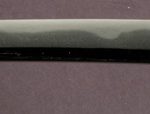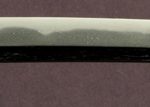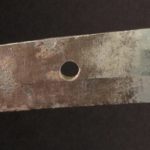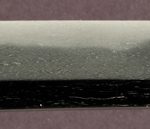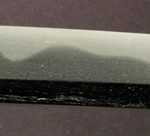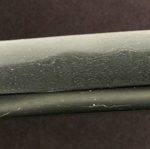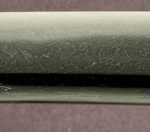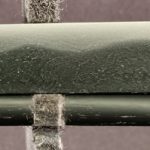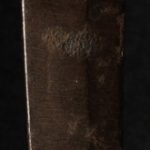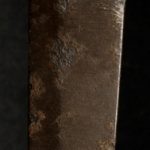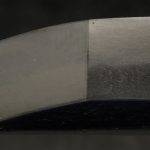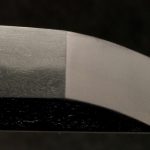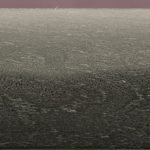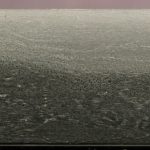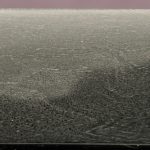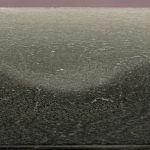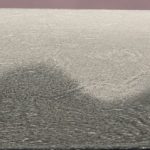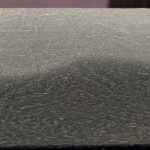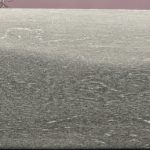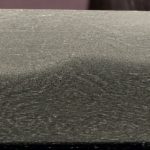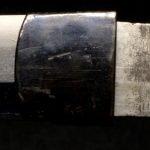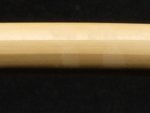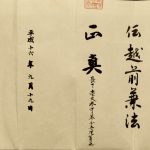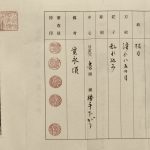KANENORI, ECHIZEN / $2800
KANENORI, ECHIZEN
NTHK KANTEISHO (PAPERS)
MEI: MUMEI
DATE: NONE, attributed to c. Kan ́ei (寛永), 1624-1644)
NAGASA: 40.163cm (15.8125″)
OVERALL: 53.34cm (21″)
MIHABA: 2.69cm (1.0625″)
KASANE: 0.476cm (0.1875″)
SORI: 0.953cm (0.375″)
NAKAGO: UBU
MEKUGI ANA: ONE
YASURIME: KIRI
MUNE: IORI
HADA: ITAME
HAMON: NOTARE GUNOME
BOSHI: MIDARE KOMI
HORIMONO OMOTE: NONE
HORIMONO URA: NONE
HABAKI: 1 PC. SHAKUDO
SHIRASAYA
NTHK KANTEISHO
From, Swordsmiths of Japan by Markus Sesko, 2015
KANENORI (兼法), 1st gen., Tenbun (天文, 1532-1555), Echizen – “Kanenori” (兼法), “Ichijōdani-jū Kanenori saku” (一乗谷住兼法作), “Echizen Ichijō-jū Kanenori saku” (越前一乗住兼法作), he was a student of a Seki Kanenori but moved in the fifth year of Tenbun (1536) at the invitation of Asakura Takakage (朝倉孝景, 1493-1548) – the shugo military governor of Echizen province – from Uruma (宇留間) to Matsuoka (松岡) in Echizen province, with the downfall of the Asakura family, he was employed by Shibata Katsuie (柴田勝家, 1522-1583) whereupon he moved to Ichijōdani (一乗谷), there exists a blade with the date signature of Tenbun ten (1541) and that mentions “Echizen Ichijō-jū,” so he was at the latest at that time in Echizen province, Kanenori stuck to the Seki-Kanenori workmanship, that means blades have mostly a somewhat wider mihaba, but he also made more slender blades, the jigane is a standing- out itame mixed with masame and shirake, the hamon is a ko-gunome-midare in ko-nie-deki or a suguha in nioi-deki, the bōshi is midare-komi, jizō, or tapers
KANENORI (兼法), 2nd gen., Tenshō (天正, 1573-1592), Echizen – “Kanenori” (兼法), “Ichijōdani-jū Kanenori” (一乗谷住兼法), “Esshū-jū Kanenori” (越州住兼法)
KANENORI (兼法), 3rd gen., Keichō (慶長, 1596-1615), Echizen – “Echizen no Kuni-jū Kanenori” (越前国住 兼法), “Echizen-jū Higo no Daijō Fujiwara Kanenori” (越前住肥後大掾藤原兼法), he came originally from Shimosaka (下坂) in Ōmi province but moved later to Echizen and became there a student the adopted son of the 2nd gen. Kanenori (兼法), he received the honorary title Higo no Daijō and succeeded as 3rd gen. of this line, he made blades with a somewhat elongated chū-kissaki and a ko-itame that is mixed with mokume, ji-nie and chikei, the hamon is a slightly undulating notare mixed with ko-gunome and ashi in ko-nie-deki, sometimes we also find a notare that is mixed with gunome and sunagashi, the bōshi is sugu with a ko-maru-kaeri or midare-komi with hakikake, the yasurime are sujikai, jō-saku
KANENORI (兼法), 4th gen., Kan ́ei (寛永, 1624-1644), Echizen – “Echizen no Kuni-jū Kanenori” (越前国住兼法)
As you can see above there were at least four known generations of Echizen Kanenori, the date given on the papers attributes this sword to den Yondai or 4th generation.
This wakizashi exhibits a nice overall sugata. The elongated or chu kissaki combined with the gentle sori gives this somewhat diminutive wakizashi an elegant look and feel. The hada is a densly forged itame with masame in the shinogi-ji. There are some very small areas of loose grain in the shinogi-ji which is nearly impossible to avoid when forging masame. Hamon is notare gunome. There is an abundance of hataraki or activity to be seen, sunagashi, nie saki, nie kozure, etc. The nakago is kiri or straight. At first look I thought perhaps it was suriage and/or perhaps slightly machi okuri as the yakidashi does not terminate directly below the Hamachi. However, as there is only one mekugi ana and its placement is appropriately located I feel the nakago was styled this way originally. If there was any movement of the machi, it was ever so slight.
Papered by the NTHK.
Great wakizashi with lots to see and study.
Price: $2800 plus S/H
If you are interested in owning this sword, contact me via the website or directly at yakiba.com@gmail.com
